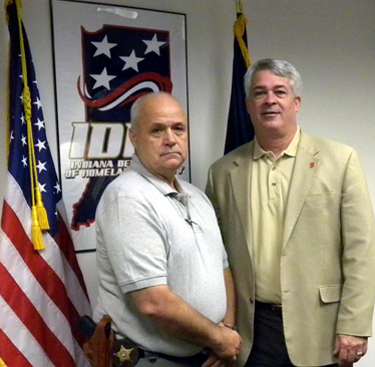 “These confirmations serve as the capstone achievement in structuralizing a concept that has been developing since 2005,” said IDHS Executive Director Joe Wainscott. “Before, during and after a disaster, the commanders have a great amount of responsibility. They are expected to oversee the structure, development, direction and response efforts of their region’s maturing emergency response task force.”
“These confirmations serve as the capstone achievement in structuralizing a concept that has been developing since 2005,” said IDHS Executive Director Joe Wainscott. “Before, during and after a disaster, the commanders have a great amount of responsibility. They are expected to oversee the structure, development, direction and response efforts of their region’s maturing emergency response task force.”
The 10 task forces are in different stages of development, but expected to be fully formed and operational by spring of 2012.
Staffed with local firefighters, law enforcement personnel, emergency medical services personnel, emergency managers, and other local emergency response professionals, the District Response Task Forces will support county emergency management agencies within the district.
During a disaster or other emergency, if the response capabilities of one or more impacted counties are overwhelmed, this network of task forces will provide a clear modus operandi for rapidly mobilizing support, Wainscott explained.
Under the guidance of IDHS, the district concept streamlines the mutual aid process enabling the counties in each district to directly support each other, and in turn, the districts to support each other as well. The system is expected to build relationships among emergency responders and increase their knowledge of available resources and capabilities to promote resource sharing.
“The crux of mutual aid agreements is resource sharing,” said Wainscott. “When equipment and personnel in every region can be made available to the entire state, we can have a much stronger response than if each county must stand on its own. When disaster strikes, we will be ready to act as a team to support and collaborate with local, state and federal partners to meet the needs of Hoosiers.”
Recommended by regional emergency response planning councils, IDHS confirms the appointment of the response task force commanders.
The commanders are responsible for overseeing daily administrative operations, and recruiting resources to establish and expand the capabilities of the task force they oversee.
When counties need additional assistance, the commanders will coordinate significant resources to assist emergency responders in their own geographic region and, if necessary, in other areas of the state.
The duties of the task force commander are voluntarily assumed as an extension of the commanders’ current positions. The commanders serve in their local communities as firefighters, law enforcement personnel, medical services personnel, emergency response planners, and in other public service roles.
Commanders also have the option to appoint one, or more, deputy commanders to assist them.
District 2 includes St. Joseph, Elkhart, Starke, Marshall, Kosciusko, Pulaski and Fulton counties.
Ron Patrick, Task Force Commander for District 2, has served in some capacity with the Indiana Army National Guard for the last 29 years. During the Olympics in 1996 Patrick’s platoon provided law enforcement support at the Georgia Dome and assisted in the response to the bombing in Centennial Park. Patrick was later hand-picked as a member of the National Guard to work as an Embedded Tactical Trainer Team Sergeant in Afghanistan with the Afghanistan National Army in 2004-2005. While serving in Afghanistan, Patrick received the Bronze Star with the Combat Distinguishing Device and the Army Commendation Medal with Valor both for actions while engaged in combat with enemy forces. He has also served Indiana as chief deputy for the Pulaski County Sheriff’s Office since 2003.
Deputy Commander Mark Tice serves with the South Bend Fire Department. Deputy Commander Jen Toby is the Elkhart County Emergency Management Agency Director and also serves with the Southwest Central Fire Territory.







